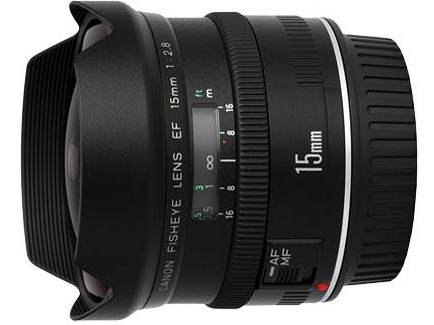
As the lens is stopped down, the clarity towards the edges of the image circle improves dramatically and between f/8 and f/11 resolution approaches excellent levels throughout the image circle.Īt 10mm, sharpness in the centre remains outstanding at maximum aperture, but the clarity towards the edges falls away somewhat. Towards the edges of the projected image circle, sharpness drops off gradually only reaching fair levels at this aperture. Thankfully the expansive depth of field can help absorb any focusing errors.Ĭanon 8-15mm f/4L Fisheye Zoom PerformanceĪt 8mm and f/4, sharpness in the centre of the frame is outstanding. This isn't necessarily an issue with the lens itself, just an observation, and one of the quirks of using a fisheye.
#Canon ef 15mm f 2 8 fisheye manual
Full time manual focus adjustments are supported, although due to the nature of the lens, it can be difficult to accurately judge focus through the viewfinder. Unfortunately there is no hyperfocal scale on the lens, which can be useful when using a fisheye. Markings are provided on the left hand side of the lens denoting where to zoom to to get a diagonal fisheye field of view for APS-C and APS-H, for example, the APS-H marking sets the lens at around 12mm.Īuto focus is extremely fast, as you may expect from a fisheye lens. Some facility to lock the lens at either 8mm, or 15mm for full frame users would also have been much appreciated, as the zoom only requires the lightest touch to move through the range. The zoom action is very smooth, if a little loose and a limiter switch can be engaged to stop the lens being zoomed to focal lengths shorter than 10m, for use on an APS-C Canon camera. The lens body is sealed against dust and moisture and the lens has a weighty solid feel to it, which compliments the Canon EOS 5D Mark III used for testing perfectly.
#Canon ef 15mm f 2 8 fisheye series
At 8mm a circular image is available, but with much of the projected picture area cropped from the top and bottom.Ĭanon 8-15mm f/4L Fisheye Zoom Handling and featuresĪs is typical of Canon L series lenses, the build quality is superb. Those using this lens on a camera with an APS-C sensor have a diagonal fisheye at 10mm with a little zoom to save cropping afterwards. With the lens zoomed to 15mm, the lens offers a diagonal fisheye image, with a field of view of 180 degrees from corner to corner.

At 8mm it provides a circular fisheye image, with a 180 degree field of view in all directions. Again, you’re getting a specific “look” from the fisheye, but you can show a massive crowd without much height.This unique lens offers two lenses in one for full frame camera users. Specifically, the 8-15mm will let you put a given subject front and center for a big part of the frame and then pull in a big environment for at the peripheral. The second type of shot that I think this could work on is large crowd shots. Because it is so wide at 15mm, the shake is minimized, which is not something we get away with very often when using HDSLRs. The other great effect of using this for POV or action shots is that you can hand hold the camera due to the extreme wide angle and not suffer greatly from camera shake. I could see this coming into play in scenes where there is a lot of peripheral action going on and you want to provide a rather chaotic view from the first-person perspective. At around 15mm, it offers a pretty cool POV shot – just a super wide shot. I also tried my hand at some video with the 8-15mm and found some pretty cool uses. As noted above, the APS-C range goes down to 10mm, while the APS-H range goes to about 12mm before vignetting sets in – a handy feature that maximizes the transition of this lens throughout Canon’s DSLR lineup.

On the 7D, you can back off to about 10mm before you start having a bad vignetting problem, which puts you at a field of view equivalent to 16mm on the 5D.Ĭanon provides markers on the side of the lens barrel to show you where the image circle covers APS-C and APS-H format cameras. The thing you notice above is the vignetting hits at totally different places with the 5D and 7D. Canon EF 8-15mm f/4L at 8mm on 5D Mark IIĪs you can see, there’s a big difference in the field of view on a full frame camera and an APS-C frame camera with this lens.


 0 kommentar(er)
0 kommentar(er)
